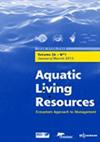DNA条形码技术在鉴定埃及苏伊士市市场鱼类种类和遗传多样性中的应用研究
IF 1.5
4区 农林科学
Q3 FISHERIES
引用次数: 3
摘要
红海是世界上生物多样性的关键地区之一。它是物种形成和生物入侵的热点。在目前的工作中,进行了一项试验性随机抽样试验,以确定到达苏伊士市鱼市的一些鱼种的特征。苏伊士市是红海北部最大的鱼市之一。对不同鱼类样本进行DNA条形码标准程序,应用细胞色素氧化酶亚基1线粒体基因(COI)的测序。DNA条形码技术可以成功地识别所有的目标鱼类,达到物种水平(>98%)。结果表明,该市场在分类上呈现出多样化的商业趋势,所收集的物种属于7个不同的鱼类科和3目。这些物种是科里aygula, Papilloculiceps异形,Priacanthus sagittarious, Gerres longirostris, Alepes djedaba, Psettodes erumei Cheilinus trilobatus, Calotomus viridescens,和Pardachirus marmoratus。前6种的单倍型多样性中等。然而,它们的核苷酸多样性很低。这可能是由于从瓶颈种群或不妨碍遗传流动的地区捕捞造成的。此外,在人马座、鲁梅和长鼻草中也发现了潜在的物种形成。将DNA条形码技术应用于苏伊士市鱼市的鱼种鉴定,可以检测到鱼种多样性的各个方面。强烈建议开展更多利用应用分析的工作,以协助红海经济渔业的适当养护和管理。本文章由计算机程序翻译,如有差异,请以英文原文为准。
A case study for application of DNA barcoding in identifying species and genetic diversity of fish from the Suez city market, Egypt
The Red Sea is one of the key areas of biodiversity in the world. It is a hotspot for speciation and biological invasions. In the current work, a pilot, random sampling trial was carried out to characterize some species in the landings reaching the fish market in Suez city, which is one of the largest fish markets in the Northern Red Sea. Samples of different fish species were subjected to the standard procedures of DNA barcoding, applying the sequencing of the cytochrome oxidase subunit 1 mitochondrial gene (COI). DNA barcoding could successfully identify all the targeted fishes to the species-level (>98%). The results exhibited a taxonomically-versatile commercial trends in this market, being the collected species belonging to 7 different fish families and 3 orders. These species were Coris aygula, Papilloculiceps longiceps, Priacanthus sagittarious, Gerres longirostris, Alepes djedaba, Psettodes erumei Cheilinus trilobatus, Calotomus viridescens, and Pardachirus marmoratus. Haplotype diversities in the first six species were moderate. However, their nucleotide diversities were low. This may have resulted from fishing from bottlenecked populations, or from areas that do not hinder the genetic flow. Also, possible cryptic speciation could be detected in P. sagittarius, P. erumei and G. longirostris. Applying the DNA barcoding for species identification in Suez city fish market could then detect various aspects of fish species diversity. More works using the applied analyses can be strongly recommended to aid proper conservation and management of economic fisheries in the Red Sea.
求助全文
通过发布文献求助,成功后即可免费获取论文全文。
去求助
来源期刊

Aquatic Living Resources
农林科学-海洋与淡水生物学
CiteScore
2.30
自引率
0.00%
发文量
10
审稿时长
>24 weeks
期刊介绍:
Aquatic Living Resources publishes original research papers, review articles and propective notes dealing with all exploited (i.e. fished or farmed) living resources in marine, brackish and freshwater environments.
Priority is given to ecosystem-based approaches to the study of fishery and aquaculture social-ecological systems, including biological, ecological, economic and social dimensions.
Research on the development of interdisciplinary methods and tools which can usefully support the design, implementation and evaluation of alternative management strategies for fisheries and/or aquaculture systems at different scales is particularly welcome by the journal. This includes the exploration of scenarios and strategies for the conservation of aquatic biodiversity and research relating to the development of integrated assessment approaches aimed at ensuring sustainable and high quality uses of aquatic living resources.
 求助内容:
求助内容: 应助结果提醒方式:
应助结果提醒方式:


